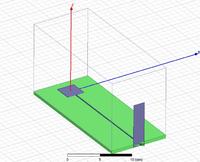eztucker
Junior Member level 2
Hello,
I have a simple question. I am modeling a microstrip patch antenna as a receiving antenna where the microstrip is terminated by a wave port to "receive" any propogating waves from the patch, which is excited by a plane wave. My question is simply: Do I need to define an integration line when using a wave port to receive radiation or will that actually excite a mode at the wave port? I have attached a picture of the model. Thanks!

Also, if anyone has an example for simulating a receiving antenna, that would be very helpful!
I have a simple question. I am modeling a microstrip patch antenna as a receiving antenna where the microstrip is terminated by a wave port to "receive" any propogating waves from the patch, which is excited by a plane wave. My question is simply: Do I need to define an integration line when using a wave port to receive radiation or will that actually excite a mode at the wave port? I have attached a picture of the model. Thanks!

Also, if anyone has an example for simulating a receiving antenna, that would be very helpful!